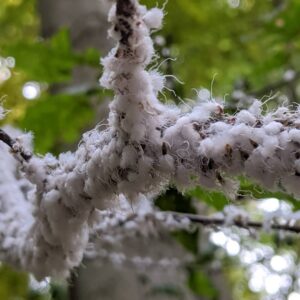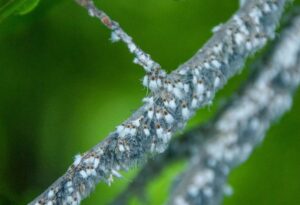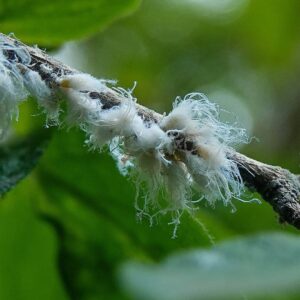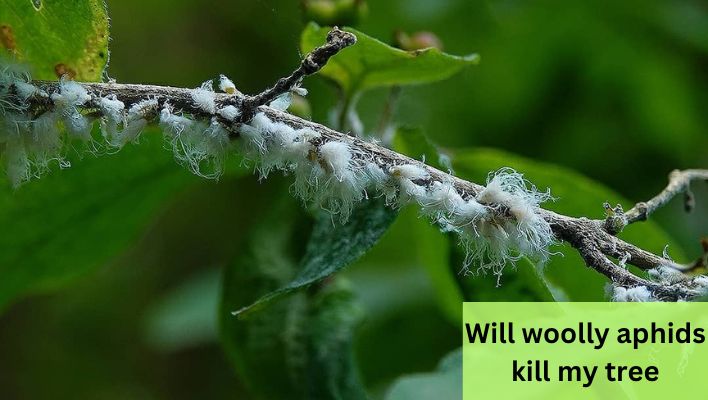You adore your trees; their majestic presence, the shade they provide on hot summer days, and the soothing rustle of their leaves in the breeze. So, when you spot those pesky woolly aphids invading your beloved tree, it’s natural to worry. Will woolly aphids kill my tree? It’s a question that looms large in the minds of every tree enthusiast.
Woolly aphids may be small in size, but their impact on trees can be significant. These sneaky pests have a knack for sapping the life out of our beloved trees, causing distress and potential long-term damage.
Understanding their potential threat is the first step towards safeguarding your trees and keeping them thriving.
Among the many challenges, woolly aphids stand out as small but formidable foes. These tiny pests have the power to wreak havoc on trees, causing distress and potential long-term damage.
In this blog, we’re diving headfirst into the world of woolly aphids to demystify their impact on your leafy companions.
These small, fuzzy critters may seem harmless, but their presence can cause significant damage if left unchecked.
From sap-sucking to the formation of honeydew and sooty mold, woolly aphids can turn your thriving tree into a weakened, struggling soul.
Below we’ll dive into the essential knowledge of identifying, managing, and preventing woolly aphid infestations. Let’s uncover the truth behind the question, “Will woolly aphids kill my tree?” and ensure your arboreal friends stay strong and healthy for years to come.
Understanding Woolly Aphids: Tiny Pests with a Fuzzy Presence
Woolly aphids, those minuscule troublemakers, may be small in size, but their impact on trees can be significant. Let’s take a closer look at these fuzzy invaders and get acquainted with their distinct characteristics.
Woolly aphids, also known as woolly apple aphids or woolly apple scales, are a group of sap-sucking insects that belong to the Aphididae family.
They earn their name from the white, wool-like wax coating that covers their bodies, giving them a distinct appearance.
These pests come in various species, but the two most common ones are the apple woolly aphid (Eriosoma lanigerum) and the woolly beech aphid (Phyllaphis fagi).
Apple woolly aphids primarily infest apple and pear trees, while woolly beech aphids have a penchant for beech trees.
Woolly aphids have a preference for certain habitats, typically favoring temperate regions with moderate climates.
They thrive in colonies, clustering around the bark, stems, and branches of trees. Their woolly covering acts as a protective shield, enabling them to withstand unfavorable conditions.

How Woolly Aphids Affect Trees
The feeding habits of woolly aphids are anything but benign. These tiny pests have a voracious appetite for sap, and they’re not afraid to indulge. Let’s explore how their feeding behavior can spell trouble for your beloved trees.
Woolly aphids use their piercing mouthparts to tap into the tree’s vascular system, extracting the sap rich in nutrients.
As they suck out the vital fluids, they weaken the tree’s ability to transport water and nutrients effectively. This constant sap depletion can lead to stunted growth, yellowing leaves, and an overall decline in the tree’s health.
But the damage doesn’t stop there. Woolly aphids have a knack for excreting a sticky substance known as honeydew.
This sugary waste product not only coats the leaves and branches but also serves as a breeding ground for sooty mold.
The dark, powdery mold not only mars the tree’s aesthetic appeal but can also interfere with photosynthesis, further compromising its vitality.
Moreover, the honeydew can attract other unwanted guests, such as ants and wasps, exacerbating the tree’s plight.
Left unchecked, a severe woolly aphid infestation can weaken a tree’s immune system, making it more susceptible to diseases and other pests.
As we can see, the impact of woolly aphids goes beyond their feeding habits. The combination of sap-sucking, honeydew secretion, and sooty mold formation can spell trouble for the overall health and vitality of your trees.
Now that we understand the potential harm they can cause, it’s crucial to assess the threat level and take appropriate measures to protect our leafy companions.
What woolly aphids do to trees
Woolly aphids can have several effects on trees. While they are unlikely to directly kill a healthy tree, their presence can lead to various issues:
- Weakening: Woolly aphids feed on the sap of trees by inserting their mouthparts into the phloem tissue. This feeding can weaken the tree’s overall health and vitality over time.
- Stunted Growth: Infested trees may exhibit stunted growth, with smaller and less vigorous foliage compared to healthy trees. The growth of branches and shoots may also be hindered.
- Leaf Damage: Woolly aphids can cause leaf curling, distortion, and discoloration. Leaves may appear yellowed, mottled, or deformed, affecting the tree’s aesthetics.
- Reduced Fruit Production: Fruit trees, such as apple and pear trees, can experience reduced fruit production due to woolly aphid infestations. The pests can directly damage developing fruits or indirectly affect fruit quality and quantity through their impact on the tree’s overall health.
- Honeydew and Sooty Mold: Woolly aphids excrete a sugary substance called honeydew. This sticky residue can coat leaves, branches, and fruits, attracting other pests like ants and wasps. The honeydew can also promote the growth of sooty mold, a black, powdery fungus that further affects photosynthesis and the tree’s overall appearance.
- Increased Susceptibility: Trees infested with woolly aphids may become more vulnerable to other pests, diseases, and environmental stresses. The weakened state of the tree makes it easier for other organisms and factors to cause further damage.
It’s important to note that the extent of damage caused by woolly aphids can vary depending on factors such as tree species, health, environmental conditions, and the severity of infestation.
Timely identification and appropriate management strategies can help minimize the impact and promote the tree’s recovery.
Identifying Woolly Aphid Infestation
Spotting a woolly aphid infestation on your trees is crucial for timely intervention. Let’s uncover the telltale signs that can help you identify these tiny troublemakers.
- Distinctive Appearance: Woolly aphids are easy to spot due to their unique white, wool-like appearance. As you inspect your tree’s bark, branches, and stems, look for clusters of tiny, fuzzy insects with a cottony covering. This distinctive coating sets them apart from other pests or insects you might encounter.
- Curled or Discolored Leaves: Infested trees often exhibit curled or distorted leaves. The feeding activities of woolly aphids can disrupt normal leaf development, leading to deformities. Additionally, these pests weaken the tree’s nutrient absorption, causing leaves to turn yellow, wilt, or show signs of premature aging.
- Presence of Honeydew: Keep an eye out for a sticky, shiny substance on the leaves and branches of your tree. This is the honeydew excreted by woolly aphids. It can accumulate in large quantities, creating a sticky mess that attracts ants and other insects.
- Sooty Mold Growth: When honeydew remains on the tree’s surfaces for an extended period, it becomes a breeding ground for sooty mold. This dark, powdery fungus can coat the leaves, stems, and branches, giving the affected areas a black, sooty appearance.
If you notice a combination of these signs, clusters of white, woolly insects, curled or discolored leaves, and the presence of honeydew or sooty mold, chances are you’re dealing with a woolly aphid infestation. Identifying the problem early on enables you to take swift action and protect your trees from further harm.

Tree Species Most Susceptible to Woolly Aphid Damage
While woolly aphids can pose a threat to various tree species, some are more prone to infestation and damage. Let’s explore the common trees that tend to attract these pesky intruders and understand why they become prime targets.
- Apple and Pear Trees: Apple woolly aphids (Eriosoma lanigerum) are especially fond of apple and pear trees. These fruit-bearing trees provide a rich sap source and serve as an ideal habitat for these insects. Infestations on apple and pear trees can not only weaken the tree but also impact fruit production, affecting both the quantity and quality of the harvest.
- Beech Trees: Woolly beech aphids (Phyllaphis fagi) have a strong affinity for beech trees. The bark of beech trees provides an inviting surface for these pests to cluster and establish colonies. The woolly aphids’ feeding activities can weaken the beech trees’ vitality, making them susceptible to other stressors such as diseases and unfavorable environmental conditions.
- Elm Trees: Elm trees are also among the favored targets for woolly aphids. These majestic trees offer ample space for colonies to thrive, with their robust branches and extensive foliage. Infestations can lead to leaf curling, discoloration, and an overall decline in the health of the elm trees.
- Pine Trees: Although woolly aphids primarily target deciduous trees, they can also infest certain species of pine trees. The sap-rich needles of pine trees serve as an attractive food source. Infestations can cause needle discoloration, stunted growth, and weaken the tree’s overall resilience.
- Maple Trees: Certain species of maple trees, such as the Norway maple (Acer platanoides), can attract woolly aphids. These pests can affect the health and aesthetics of maple trees, leading to leaf curling, discoloration, and reduced vigor.
- Oak Trees: While oak trees are generally resilient, they can still fall victim to woolly aphids. The presence of woolly aphids on oak trees can cause leaf distortion, yellowing, and reduced growth rates.
- Willow Trees: Willow trees, known for their graceful appearance and drooping branches, can become targets for woolly aphid infestations. These pests can weaken the willow trees, leading to leaf deformation and a decline in overall vigor.
- Poplar Trees: Poplar trees, including species like cottonwood (Populus deltoides), can be susceptible to woolly aphid damage. Infested trees may exhibit leaf curling, yellowing, and a reduction in growth rates.
- Pineapple Guava Trees: In addition to traditional tree species, woolly aphids can also affect certain fruit trees like the pineapple guava (Feijoa sellowiana). These pests can impact fruit production and weaken the overall health of the tree.
- Japanese Maple Trees: Japanese maple trees (Acer palmatum), known for their delicate and ornamental foliage, can also attract woolly aphids. Infestations can lead to distorted leaves, reduced growth, and overall aesthetic degradation.
The preference of woolly aphids for specific tree species is often influenced by the availability of suitable sap sources and environmental factors.
These trees may produce sap that is particularly appealing or provide ideal conditions for the pests to establish colonies. The consequences of woolly aphid infestations on susceptible trees can be far-reaching.
Beyond the direct damage to foliage and sap depletion, weakened trees become vulnerable to secondary infections, diseases, and other pest infestations.
It’s vital to be proactive in identifying and addressing woolly aphid infestations in these vulnerable tree species to maintain their health and preserve their beauty for years to come
Will Woolly Aphids Kill My Tree?
The concern lingers: will those woolly aphids bring an untimely demise to your cherished tree? The answer, in short, is that woolly aphids alone are unlikely to be the sole cause of a healthy tree’s death. Let’s dive deeper and understand the dynamics at play.
While woolly aphids can certainly weaken a tree, leading to stunted growth, leaf discoloration, and other signs of distress, their impact alone is typically not fatal.
Trees possess remarkable resilience and can withstand many challenges, including pest infestations. However, it’s essential to address the issue promptly to prevent further damage and ensure the tree’s long-term health.
In most cases, the death of a tree is a result of a combination of factors or secondary issues. Woolly aphids can contribute to a tree’s decline by compromising its ability to absorb nutrients and water.
This weakened state can make the tree more susceptible to other stressors, such as diseases, extreme weather conditions, or additional pest infestations.
Moreover, the waste products of woolly aphids, such as honeydew and sooty mold, can exacerbate the tree’s predicament.
The accumulation of honeydew can attract other pests, disrupt photosynthesis, and interfere with the tree’s overall metabolic functions. Sooty mold can further impede the tree’s ability to thrive.
To protect your tree from potential harm, it’s crucial to take proactive measures. Regularly inspect your tree for signs of woolly aphid infestations, such as the characteristic white, wool-like clusters, curled leaves, or the presence of honeydew and sooty mold.
Implement appropriate control methods, such as pruning affected branches, applying insecticides, or introducing natural predators.
Remember, healthy trees can usually overcome the challenges posed by woolly aphids. By addressing infestations and providing optimal growing conditions, you can bolster your tree’s resilience and increase its chances of thriving.
So, while woolly aphids can weaken a tree, their presence alone is unlikely to seal its fate. Stay vigilant, and your leafy companion will continue to grace your surroundings for years to come.

Prevent and Control Woolly Aphids
While woolly aphids may pose a challenge, there are effective strategies to prevent and control their infestation. Let’s explore a range of methods, from natural approaches to chemical treatments, to help you combat these fuzzy intruders and protect your trees.
- Pruning: Regularly inspect your trees and promptly remove any infested branches or twigs. Pruning helps eliminate woolly aphid colonies and prevents their spread to other parts of the tree.
- Beneficial Insects: Encourage natural predators and parasites of woolly aphids to establish a balanced ecosystem. Ladybugs, lacewings, hoverflies, and parasitic wasps are beneficial insects that feed on aphids. Planting nectar-rich flowers and avoiding broad-spectrum insecticides can attract and sustain these helpful allies.
- High-Pressure Water Spray: A forceful spray of water can dislodge woolly aphids from tree surfaces. Use a garden hose or a pressure washer on a gentle setting to remove the pests. Repeat this method regularly to prevent re-infestation.
- Horticultural Oils: Apply horticultural oils, such as neem oil or insecticidal soaps, following the product instructions. These oils suffocate woolly aphids and disrupt their life cycle. Apply during the dormant season or when temperatures are suitable to avoid any potential damage to the tree.
- Systemic Insecticides: In severe infestations, systemic insecticides can be considered as a last resort. These chemicals are absorbed by the tree, making it toxic to woolly aphids. Consult with a professional arborist or follow the instructions provided by the manufacturer to ensure safe and effective use.
- Cultural Practices: Maintain overall tree health by providing proper irrigation, balanced fertilization, and regular pruning. Strong and healthy trees are more resilient to woolly aphid infestations and can recover more effectively.
- Barrier Methods: Implement physical barriers, such as sticky bands or tree wraps, around the trunk to prevent woolly aphids from crawling up and infesting the tree.
- Monitor and Early Detection: Regularly inspect your trees for signs of woolly aphids. Early detection allows for prompt action, minimizing potential damage and the need for more aggressive control measures.
- Beneficial Nematodes: Consider using beneficial nematodes, such as Steinernema feltiae, which are natural predators of woolly aphids. These microscopic worms can be applied to the soil around the tree, targeting aphid larvae and reducing their population.
- Reflective Mulch: Place reflective mulch, such as aluminum foil or reflective plastic, around the base of the tree. The reflective surface can deter woolly aphids from crawling up the trunk.
- Sticky Traps: Set up sticky traps near affected trees to capture and monitor woolly aphids. These traps act as a physical barrier and can help reduce the population of these pests.
- High-Quality Planting: When selecting new trees for your landscape, choose species that are less susceptible to woolly aphid infestation. Research and consult with local arborists or horticulturists to identify tree varieties with natural resistance to woolly aphids.
- Regular Cleaning: Keep your garden and surroundings clean by removing fallen leaves, debris, and weeds. This reduces potential hiding places and breeding grounds for woolly aphids.
- Vigilant Inspections: Regularly inspect nearby plants and garden areas for signs of woolly aphids. Promptly address any infestations in neighboring plants to prevent them from spreading to your trees.
Remember, a combination of strategies tailored to your specific situation often yields the best results. Choose the methods that align with your preferences, environmental considerations, and the severity of the infestation. By implementing proactive measures, you can protect your trees from woolly aphid damage and ensure their long-term health and beauty.
Will Woolly Aphids Kill Tree FAQs
How long do woolly aphids live?
The lifespan of woolly aphids can vary depending on environmental conditions and the species. Generally, adult woolly aphids can live for a few weeks to several months.
Can woolly aphids spread to other trees or plants?
Yes, woolly aphids can spread to neighboring trees and plants. They can crawl or be transported by wind, insects, birds, or even humans. It’s important to address infestations promptly to prevent their spread.
Do woolly aphids only infest fruit trees?
No, while woolly aphids are commonly found on fruit trees like apples and pears, they can infest various other tree species as well, including beech, elm, maple, and pine trees.
Can woolly aphids be controlled without chemicals?
Yes, there are several natural control methods available to manage woolly aphids. These include pruning infested branches, encouraging beneficial insects like ladybugs, using high-pressure water sprays, applying horticultural oils or insecticidal soaps, and implementing cultural practices to promote tree health.
Conclusion
Understanding the impact of woolly aphids on trees is crucial for tree owners and garden enthusiasts.
While woolly aphids can weaken trees and affect their health, it is unlikely that they will directly cause the death of a healthy tree.
The real danger lies in the combination of factors or secondary issues that can arise from woolly aphid infestations.
Identifying and monitoring woolly aphid infestations is key to preventing further damage. Prompt actions, such as pruning affected branches, encouraging beneficial insects, and employing natural control methods, can help manage woolly aphid populations effectively.
Chemical treatments should be considered as a last resort and used with caution, keeping in mind their potential impact on the environment.
Certain tree species, like apple, pear, beech, elm, and maple trees, are more susceptible to woolly aphid damage. However, all trees should be monitored and protected to maintain their overall health and vitality.
By implementing proactive measures, such as regular inspections, practicing good tree care, and utilizing appropriate control methods, tree owners can mitigate the impact of woolly aphids and preserve the beauty and longevity of their trees.
Remember, healthy and well-maintained trees have a better chance of withstanding woolly aphid infestations and other challenges they may face. So, stay vigilant, take action when needed, and enjoy the thriving beauty of your trees for years to come.
